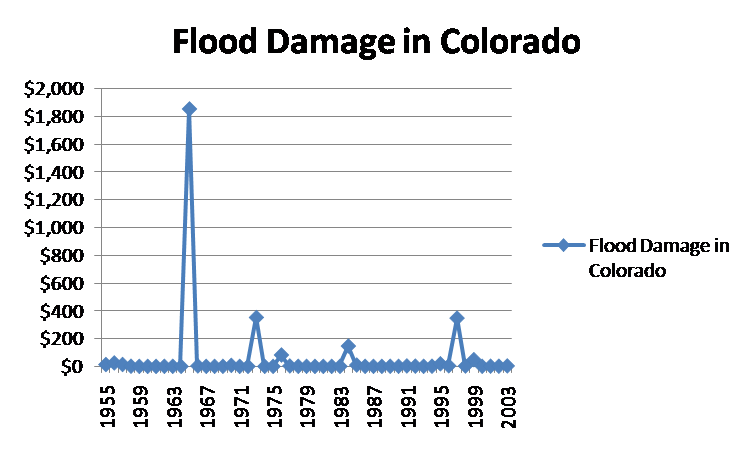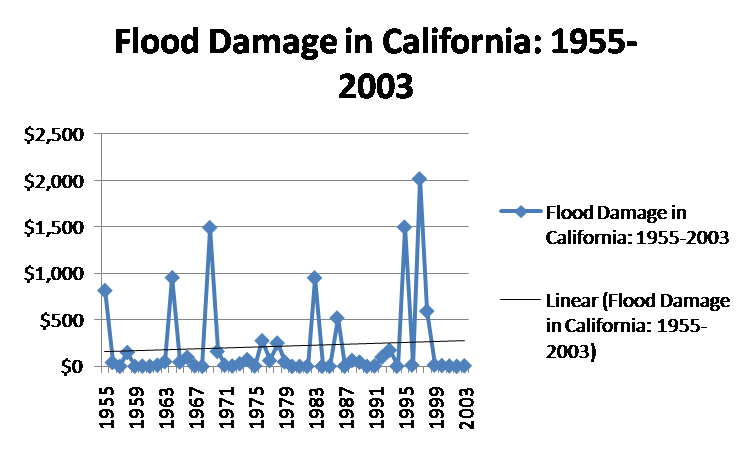Precipitation and Flood Damage
December 6th, 2007Posted by: Roger Pielke, Jr.
I was just contacted by a reporter who is doing a story based on a news release put out by a group called Environment Colorado. The news release says that Colorado has seen a 30% increase in extreme precipitation over the past 60 years, based on a new study called “When it Rains, It Pours” (PDF).
The thing is, there has been no increase in flood damage in Colorado (from 1955-2003 in our dataset), as can be seen in the following graph.

This data has only been adjusted for inflation. Given the pace of growth and development in Colorado, one could make a strong case that flood impacts have gone down pretty sharply in per capita or per unit wealth terms. So it may very well be the case that extreme precipitation has increased, but these measures of precipitation are not well correlated with flood damage, which is what Mary Downton and I found in a 2000 study.
Just for fun I also looked at California, which was the subject of a different press release put out by Environment California, and guess what? Extreme precipitation is up 26% in California, and there is no statistically significant trend in damage, even without considering population growth and development.

So while human caused climate change may be responsible for changes in “extreme” precipitation, these measures are not well correlated with damaging floods.
December 9th, 2007 at 2:03 pm
I’m very active with the Santa Clara Valley Water District. The District spends a great deal of money on flood protection, and expects it will have to spend a lot more in the near future because of climate change, mostly due to rebuilding and raising levees along San Francisco Bay.
All these expenditures are missing from your argument. I expect a chart showing expenditures on flood protection would show a significant rise over the last 50 years. Your charts only show half of the equation.
Incidentally, it would be interesting to see a similar chart for Louisiana.
December 9th, 2007 at 2:42 pm
Brian S.-
Here is a graph for Louisiana 1955-1999 (and just FYI, note that Katrina in 2005 would not be classified a flood under the NWS methods, but instead under hurricane damage):
http://www.sip.ucar.edu/sourcebook/flood/lafld.jsp
The notion that flood protection reduces flood damages is Fallacy #3 in the following paper:
Pielke Jr., R.A., 1999: Nine fallacies of floods. Climatic Change, 42, 413-438.
http://sciencepolicy.colorado.edu/admin/publication_files/resource-78-1999.15.pdf
New Orleans, Louisiana would seem to be exhibit A in that argument. And I discussed this issue at length in this post:
http://sciencepolicy.colorado.edu/prometheus/archives/disasters/000670does_disaster_mitiga.html
Thanks!
December 10th, 2007 at 1:53 am
Actually, levees do stop floods. Overstating legitimate criticism against structural means for flood protection does nothing for your case. I strongly prefer and professionally advocate for other methods – removing development from riparian buffer zones and the most severe flooding areas – but I don’t argue against physics.
If you want to consider expense, though, nothing matches the expense of removing all of San Francisco Bay’s levees and abandoning all development built behind the levees.
If for some reason you wish to discuss non-structural expenses used for flood protection, I expect those expenses will have gone up much faster in the last 50 years.
December 10th, 2007 at 2:14 am
Roger,
(still problems leaving a comment…I am signed into TypeKey, but Prometheus
apparently doesn’t think so…)
Comment on California Flooding (Dec 6th Precipitation and Flood Damage
article):
A paper that just recently appeared in Geophysical Research Letters by
Florsheim and Dettinger (Florsheim, J.L, and M.D. Dettinger, 2007. Climate
and floods still govern California levee breaks. Geophysical Research
Letters, 34, L22403, doi:10.1029/2007GL031702) examined flooding in the
Sacramento-San Juan River systems of California over the past 150 years or
so and concluded that despite “extensive flood control infrastructure
developed during the 20th Century” the frequency of flooding (identified as
levee breaks) was unchanged-and not because the flood control
efforts/expenditures were offsetting climate change-related river flow
trends (they checked that).
-Chip Knappenberger